Old Photographs Depicting London In The Reign Of Queen Victoria
Undeniably, during the reign of Queen Victoria, England ruled as the world’s foremost power. London, the world’s largest city and the heart of the British Empire, grew into a prosperous and bustling metropolis, giving the impression of a place overflowing with abundance. Majestic palaces and towering buildings showcased the wealth of a vast colonial empire.
However, beneath this glossy surface, a harsh reality existed. The city struggled with deep poverty, sharply contrasting with the richness above.
Below are some striking images of Victorian London that bring the historical city back to life, often revealing how poor and destitute the city was.
The situation in London at the end of the 19th century
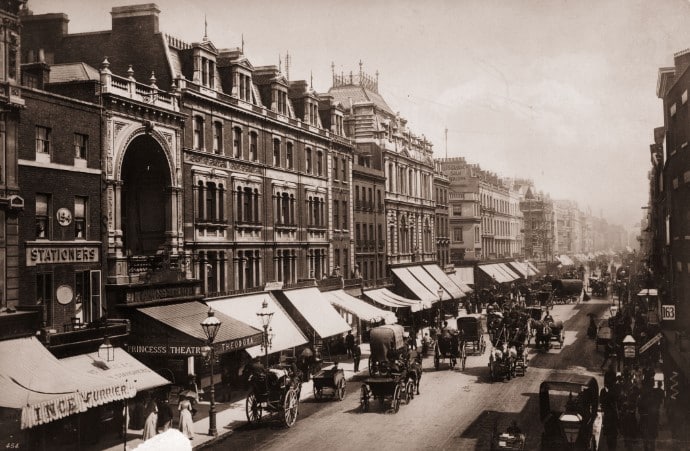
In the 19th century, London underwent a dramatic transformation with the population soaring from over 1 million in 1801 to 5.5 million in 1891. By 1897, the population of “Greater London,” which included the Metropolitan Police District and the City of London, was approximately 6.3 million.
By the 1860s, this number was intensively increasing. It was reported that London’s population was significantly larger than other major cities: a quarter larger than Beijing, two-thirds larger than Paris, and five times larger than New York City.
Despite the obvious wealth in places like London and Westminster, there was a large underclass of extremely poor Londoners living close to these affluent areas.
Vivid depictions of poverty’s harsh reality in old photos
In The Mysteries of London, the author George W. M. Reynolds depicted the vast wealth disparities and misery of London’s poorest in 1844:
“The most unbounded wealth is the neighbor of the most hideous poverty…the crumbs which fall from the tables of the rich would appear delicious viands to starving millions, and yet these millions obtain them not!
In that city there are in all five prominent buildings: the church, in which the pious pray; the gin-palace, to which the wretched poor resort to drown their sorrows…
…the pawn-broker’s, where miserable creatures pledge their raiment, and their children’s raiment, even unto the last rag, to obtain the means of purchasing food, and – alas! too often – intoxicating drink…”
John Thomson and Adolphe Smith’s Street Life in London (1877–78) have many photographs that describe the life of the poor.

This photo captured an Italian man selling halfpenny ices in 1876. The book noted that “ice men constitute a distinct feature of London life.” Selling ice cream on the streets was a common job for Italian immigrants in London at that time.
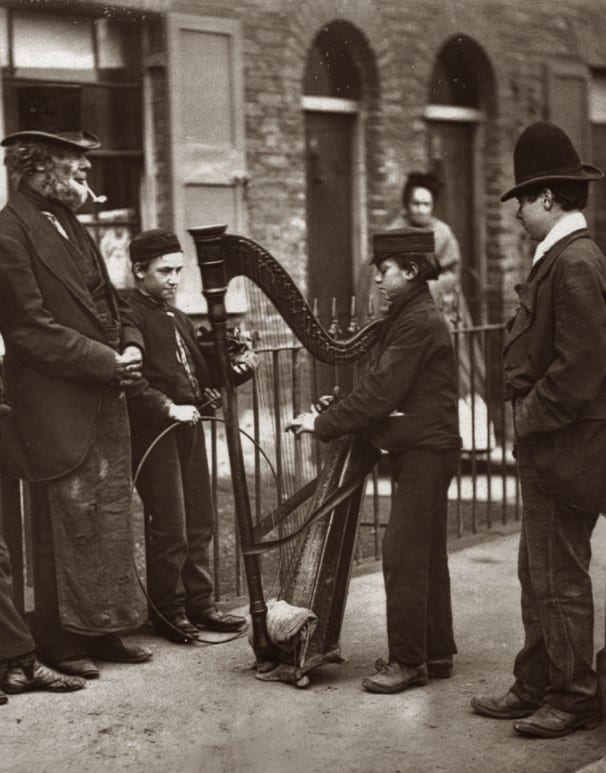
This photograph depicts an Italian boy playing the harp to entertain people passing by. During this period, many Italians migrated to London because they believed “a beggar in England is richer than a laborer in Italy.”

The photograph titled “Child Shoeblack” was taken by John Thomson. It shows a young, self-employed shoeblack polishing the boots of a city gentleman. In 1877, these shoeblacks needed a yearly license that cost five shillings.
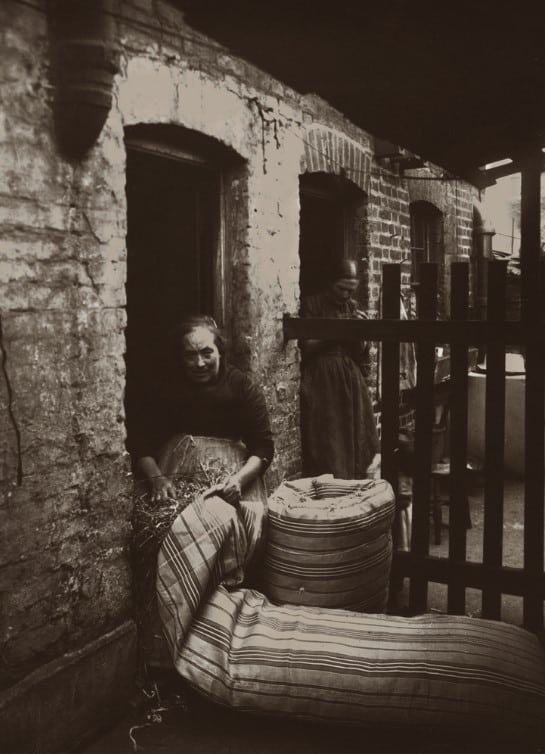
Another photograph, taken by John Galt, a missionary and amateur photographer, features Mrs. Robinson making mattresses outside her home in the East End. He captured her stuffing straw into the mattresses. For each mattress she completed, she earned one shilling. Galt, who worked with the London City Mission, took many photographs to document the conditions in the East End and highlight the mission’s efforts.
The hardships of late 19th and early 20th century London life etched on the faces of mattress stuffers, ice cream sellers, and street musicians. Despite their struggles, an occasional smile is still caught.
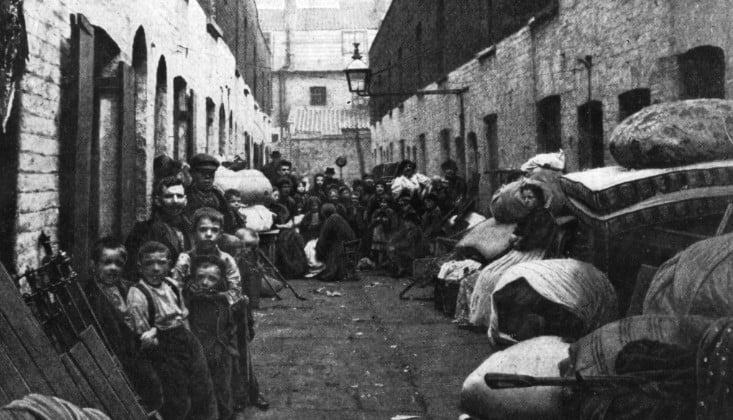
The East End of London, focused on the Docklands and the polluting industries along the Thames and River Lea, has always been a hub for the working poor. By the late 19th century, it had become infamous for its overcrowding, severe poverty, and vice.
In 1903, American author Jack London wrote “The People of the Abyss,” where he shared his surprise at how shocked Londoners were when he said he planned to visit the East End. Many locals had never set foot there, despite living in the same city.
“Nowhere in the streets of London may one escape the sight of abject poverty, while five minutes’ walk from almost any point will bring one to a slum; but the region my hansom was now penetrating was one unending slum.
The streets were filled with a new and different race of people, short of stature, and of wretched or beer-sodden appearance.
We rolled along through miles of bricks and squalor, and from each cross street and alley flashed long vistas of bricks and misery.”
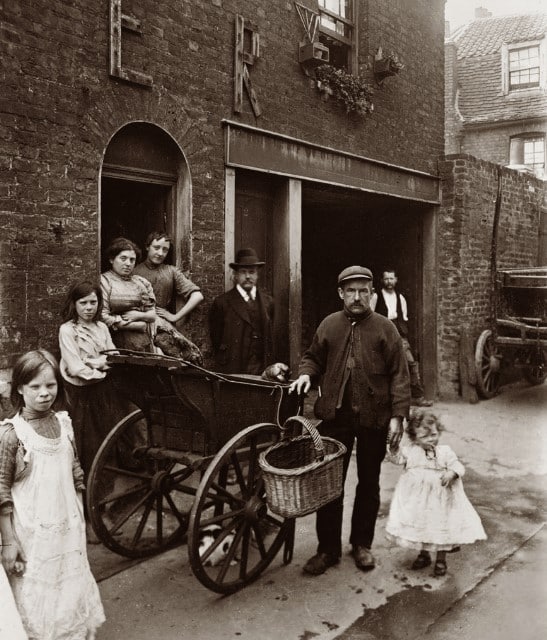
This photo, taken in 1901, shows a cat’s meat man outside a poor home in the East End of London. These men roamed the streets with their carts, selling leftover meat scraps from slaughterhouses as food for cats. Often, it was horsemeat, which was not safe for people to eat.
The writing on the side of the house celebrates the coronation of King Edward VII. The well-dressed man in the middle is a missionary from the London City Mission.
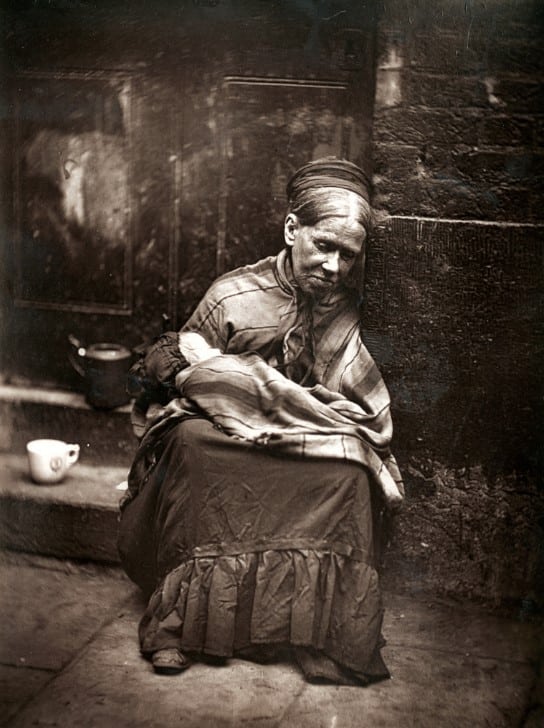
Homeless people, often called “crawlers” because they moved from one shelter to another, were a familiar sight in Victorian London. This image captures a woman and her young son, highlighting the everyday struggles faced by many during that era.

A young girl named Hookey Alf waited outside a London pub with the hope of finding work with coal merchants. It’s heartbreaking to know that even a child had to try to earn money to survive.

A mother and her kids worked together making matchboxes. The kids went to the match factory to get the wood and paper and bring back the finished boxes. This was one of the worst-paid jobs, with families only getting two pennies for making 144 boxes. They usually had to buy their own paste and string to bundle them up.

A tired young mom sat by a table piled high with matchboxes she’d made. Beside her, a little child sleeps under a blanket. For these home workers in the matchbox industry, there wasn’t a line between work and home life. They often felt exhausted because they worked around 16 hours every day.

